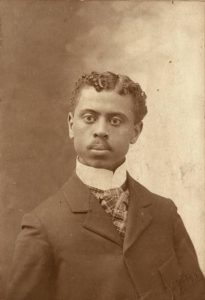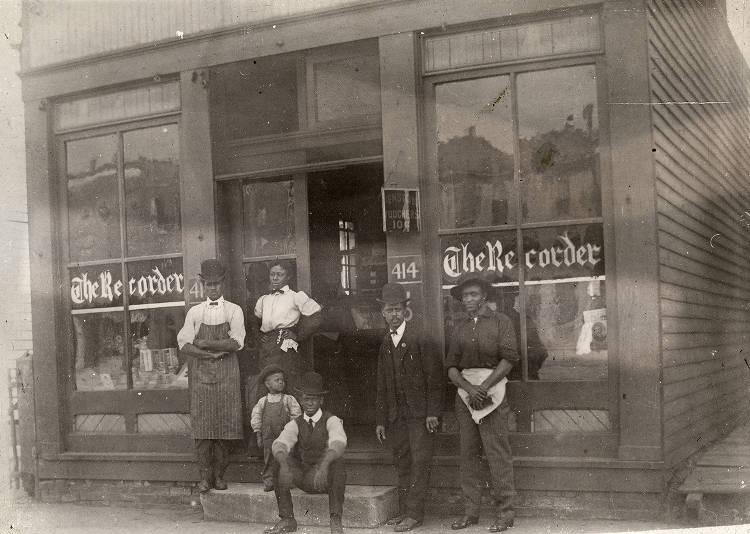
Photo info …
Credit: Indianapolis Recorder Collection, Indiana Historical SocietyView Source
(Mar. 13. 1874-Aug. 28, 1924). Founder of the , George Pheldon Stewart was born in Vincennes, Indiana, to William H. and Josephine Stewart. He moved to Indianapolis in 1894 and married Louisville native, Fannie Belle Caldwell in September 1898. The Stewarts had six children.
In his youth, Stewart learned a great deal of the printing trade from his brother Charles, a skill George Stewart used to start a one-page advertising sheet in Indianapolis called The Directory, a forerunner of the Recorder. Stewart sold advertising for this sheet and filled the remaining space with church announcements. He delivered the sheets to various churches for distribution.
Soon after arriving in Indianapolis, Stewart joined . The pastor, Reverend D. A. Graham, suggested that Stewart take over its publication, the Church Recorder, as early as 1895. Graham hoped that he would use the opportunity to expand the publication’s scope beyond church news to highlight African Americans’ involvement in Indianapolis fraternities and societies. Stewart fulfilled this hope in 1897, partnering with Will H. Porter to establish the Indianapolis Recorder. How the two men became associated remains unclear. The newspaper’s first offices were at 122 W. New York Street. Porter sold his share of the newspaper to Stewart for $300 in 1899.

Stewart differentiated the Recorder from its competitors, mainly the and the , by devoting a larger proportion of its content to local news. In its early years, much of what appeared in its pages revolved around ministers, churches, and religious news. Later, national news appeared on page one, and it often took the form of an appeal. Stewart continued to focus one page on church news, while also printing articles that promoted and examined Black progress and local community and society news.
As publisher and editor of the Recorder, Stewart served as a nerve center for communication among members of the African American community. Strangers sought his advice, wrote to him in search of addresses of Indianapolis residents, and asked for recommendations of individuals who could perform a variety of services for them.

Stewart used his print shop and newspaper to aid the political causes and Black businesses he supported. He took care of the printing needs of local businesses and produced handbills and other items for politicians. Throughout his tenure as editor and publisher of the Recorder, Stewart supported the Republican Party. He not only expressed his support for the party through his newspaper but also through his activities in the Indiana Association of Colored Men and the Indiana Negro Welfare League. Both were African American Republican organizations.
Stewart served as chairman of the Colored Republican Committee, headquartered at 541 ½ Indiana Avenue. In this position, he endorsed Kentland native Warren T. McCray for governor of Indiana in 1920. In November of that year, he issued a statewide call on behalf of the Indiana Negro Welfare League, suggesting the Colored Republican Committee develop a constitutional plan for representation in the state body and a budget. Stewart also confirmed William Pickens, field secretary for the , and Governor-elect Warren T. McCray as speakers at the December 21, 1920, League meeting at Bethel AME Church.
By the second decade of the 20th century, Stewart was active in several business and fraternal organizations. To further promote the business and political progress of Blacks, he joined the Indiana chapter of the National Negro Business League. He was affiliated with the Waterford Lodge # 13; F. & A.M. Marion Lodge #5, Knights of Pythias; Persian Temple #46; Nobles Mystic Shrine; and the Indianapolis Camp of the American Woodsman. The Recorder also provided publicity to these fraternal and institutional connections.
After Stewart died, Fannie C. Stewart, his widow, became the Recorder’s owner and publisher; his son, Marcus, became managing editor; and his daughter, Joyce Thompson, continued in the role of business manager. The Recorder remained in the Stewart family until 1988 when the controlling interest was sold to Eunice Trotter.

Help improve this entry
Contribute information, offer corrections, suggest images.
You can also recommend new entries related to this topic.

